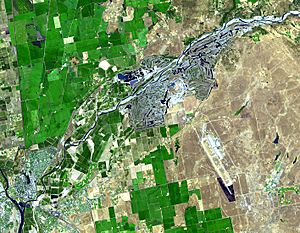Yuba Goldfields facts for kids
The Yuba Goldfields are the biggest area in California where gold was dug up using special machines called dredges. This area is also known as the Hammonton dredge field. It's found along the Yuba River, about 6 to 12 miles (10 to 19 km) upstream from the town of Marysville in Yuba County. Gold dredging happened here from 1904 to 1968. During that time, over 1 billion cubic yards (760 million cubic meters) of river dirt and old mining waste were dug up. This work produced an estimated 5.14 million ounces (146,000 kg) of gold!
The Yuba Goldfields look very unusual because of the gold dredging. You can see long lines of gravel mounds, deep ditches, small streams, and bright blue pools of water. From an airplane, some people say the goldfields look like intestines. Today, many animals live here, including wild turkeys, deer, ducks, Beavers, herons, bald eagles, river otters, and even mountain lions.
Contents
History of Gold Mining
At first, miners in the Yuba area looked for gold by panning in riverbeds. But soon, big mining companies took over from individual prospectors. These companies moved into the Sierra Nevada foothills. They used a method called hydraulic mining. This meant blasting hillsides with powerful jets of water. After the gold was taken out in long wooden sluices, the leftover mud and gravel, called "slickens," was dumped back into the mountain valleys.
Rivers and streams carried this flood of sediment down to the Sacramento Valley. A huge amount of this mining waste, between 326 million and 685 million cubic feet (9.2 million to 19.4 million cubic meters), ended up in the Yuba River. This made the riverbed much higher, sometimes by as much as 100 feet (30 m). This caused floods that buried farms near Marysville with gravel, mud, and even harmful chemicals like mercury and arsenic from the mining process. Since the Yuba River flows into the Sacramento River, much of this waste also reached the San Francisco Bay. In Sacramento, the I Street Bridge even had to be raised 20 feet (6.1 m) because of the rising riverbed. Farmers sued the mining companies, and hydraulic mining was stopped in 1883. But the "slickens" remained in the rivers.
Dredging for Gold
In 1893, a group called the California Debris Commission started to dredge the Yuba River near Marysville. They did this to clean up the environmental damage from hydraulic mining. They piled the gravel along the riverbanks. Later, in 1904, a man named W.B. Hammon brought the first bucket-line gold dredge to the area. By the end of that year, two such dredges were working. The Hammonton dredge field quickly became one of the busiest dredge fields in California. By 1908, 14 gold dredges were operating there!
Most of the dredging was done away from the main river channel. The goal was to find gold in the river sediments. This "off-channel" dredging created the long gravel piles, called tailing windrows, that you can see from above today. Even though some old mining waste (slickens) was in the area, the dredgers mostly looked for the natural river sediments. This dredge field is the largest in California, both in how much material was dug up and how much gold was found. The dredgers also created over 200 ponds. These ponds are fed by underground rivers because the ground is very porous (full of tiny holes). The water in these ponds is usually clear and blue because the gravel filters out impurities.
Later Years and What's Left
In the 1900s, mining companies tried to get more gold from the leftover gravel. Even though the gold was hard to find, this area was the main source of gold in California for a while. Two towns, Hammonton and Marigold, were built for the miners and their families. But most people left these towns after 1957. By the 1970s, it was too expensive to find any more gold. The leftover gravel then became a source of aggregate, which is a key ingredient for making concrete. It's thought that there might be up to $15 billion worth of aggregate in the goldfields, though the mining industry doesn't fully agree with that number.
The dredging caused a lot of environmental damage. The top 150 feet (46 m) of many square miles of land were turned upside down. The soil and rocks were separated, with the rocks piled on top of the soil.
Environmental Role
The Yuba River is very important for fish. In California's Central Valley, it's one of only two rivers where Chinook salmon lay their eggs. It's also the only river that supports steelhead trout runs. When salmon reach fresh water to lay eggs, they eventually die. Their bodies pile up in the goldfields, providing food for animals like turkey vultures.
Future as a Nature Reserve?
There's an idea to create a nature reserve along the lower Yuba River, which would include parts of the Yuba Goldfields. However, figuring out who owns the land and how to manage it could take many years. Creating a reserve would also cost a lot of money. Some people think that selling the aggregate (gravel) could help pay for much of it. As of September 2016, talks were still happening. The latest idea is a project to restore the habitat, led by the United States Fish and Wildlife Service.


